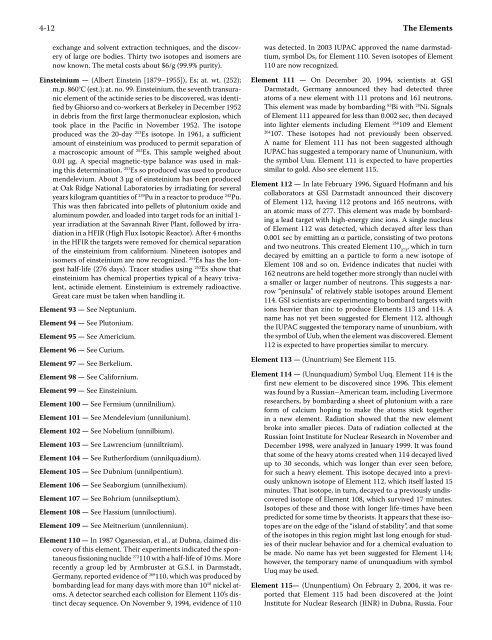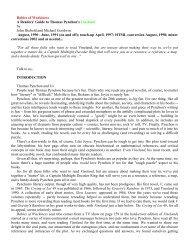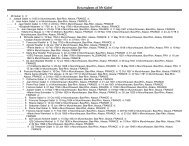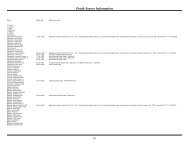CRC Handbook of Chemistry and Physics, 86th Edition
CRC Handbook of Chemistry and Physics, 86th Edition
CRC Handbook of Chemistry and Physics, 86th Edition
Create successful ePaper yourself
Turn your PDF publications into a flip-book with our unique Google optimized e-Paper software.
4-12 The Elements<br />
exchange <strong>and</strong> solvent extraction techniques, <strong>and</strong> the discovery<br />
<strong>of</strong> large ore bodies. Thirty two isotopes <strong>and</strong> isomers are<br />
now known. The metal costs about $6/g (99.9% purity).<br />
Einsteinium — (Albert Einstein [1879–1955]), Es; at. wt. (252);<br />
m.p. 860°C (est.); at. no. 99. Einsteinium, the seventh transuranic<br />
element <strong>of</strong> the actinide series to be discovered, was identified<br />
by Ghiorso <strong>and</strong> co-workers at Berkeley in December 1952<br />
in debris from the first large thermonuclear explosion, which<br />
took place in the Pacific in November 1952. The isotope<br />
produced was the 20-day 253 Es isotope. In 1961, a sufficient<br />
amount <strong>of</strong> einsteinium was produced to permit separation <strong>of</strong><br />
a macroscopic amount <strong>of</strong> 253 Es. This sample weighed about<br />
0.01 µg. A special magnetic-type balance was used in making<br />
this determination. 253 Es so produced was used to produce<br />
mendelevium. About 3 µg <strong>of</strong> einsteinium has been produced<br />
at Oak Ridge National Laboratories by irradiating for several<br />
years kilogram quantities <strong>of</strong> 239 Pu in a reactor to produce 242 Pu.<br />
This was then fabricated into pellets <strong>of</strong> plutonium oxide <strong>and</strong><br />
aluminum powder, <strong>and</strong> loaded into target rods for an initial 1year<br />
irradiation at the Savannah River Plant, followed by irradiation<br />
in a HFIR (High Flux Isotopic Reactor). After 4 months<br />
in the HFIR the targets were removed for chemical separation<br />
<strong>of</strong> the einsteinium from californium. Nineteen isotopes <strong>and</strong><br />
isomers <strong>of</strong> einsteinium are now recognized. 254 Es has the longest<br />
half-life (276 days). Tracer studies using 253 Es show that<br />
einsteinium has chemical properties typical <strong>of</strong> a heavy trivalent,<br />
actinide element. Einsteinium is extremely radioactive.<br />
Great care must be taken when h<strong>and</strong>ling it.<br />
Element 93 — See Neptunium.<br />
Element 94 — See Plutonium.<br />
Element 95 — See Americium.<br />
Element 96 — See Curium.<br />
Element 97 — See Berkelium.<br />
Element 98 — See Californium.<br />
Element 99 — See Einsteinium.<br />
Element 100 — See Fermium (unnilnilium).<br />
Element 101 — See Mendelevium (unnilunium).<br />
Element 102 — See Nobelium (unnilbium).<br />
Element 103 — See Lawrencium (unniltrium).<br />
Element 104 — See Rutherfordium (unnilquadium).<br />
Element 105 — See Dubnium (unnilpentium).<br />
Element 106 — See Seaborgium (unnilhexium).<br />
Element 107 — See Bohrium (unnilseptium).<br />
Element 108 — See Hassium (unniloctium).<br />
Element 109 — See Meitnerium (unnilennium).<br />
Element 110 — In 1987 Oganessian, et al., at Dubna, claimed discovery<br />
<strong>of</strong> this element. Their experiments indicated the spontaneous<br />
fissioning nuclide 272 110 with a half-life <strong>of</strong> 10 ms. More<br />
recently a group led by Armbruster at G.S.I. in Darmstadt,<br />
Germany, reported evidence <strong>of</strong> 269 110, which was produced by<br />
bombarding lead for many days with more than 10 18 nickel atoms.<br />
A detector searched each collision for Element 110’s distinct<br />
decay sequence. On November 9, 1994, evidence <strong>of</strong> 110<br />
was detected. In 2003 IUPAC approved the name darmstadtium,<br />
symbol Ds, for Element 110. Seven isotopes <strong>of</strong> Element<br />
110 are now recognized.<br />
Element 111 — On December 20, 1994, scientists at GSI<br />
Darmstadt, Germany announced they had detected three<br />
atoms <strong>of</strong> a new element with 111 protons <strong>and</strong> 161 neutrons.<br />
This element was made by bombarding 83 Bi with 28 Ni. Signals<br />
<strong>of</strong> Element 111 appeared for less than 0.002 sec, then decayed<br />
into lighter elements including Element 268 109 <strong>and</strong> Element<br />
264 107. These isotopes had not previously been observed.<br />
A name for Element 111 has not been suggested although<br />
IUPAC has suggested a temporary name <strong>of</strong> Unununium, with<br />
the symbol Uuu. Element 111 is expected to have properties<br />
similar to gold. Also see element 115.<br />
Element 112 — In late February 1996, Siguard H<strong>of</strong>mann <strong>and</strong> his<br />
collaborators at GSI Darmstadt announced their discovery<br />
<strong>of</strong> Element 112, having 112 protons <strong>and</strong> 165 neutrons, with<br />
an atomic mass <strong>of</strong> 277. This element was made by bombarding<br />
a lead target with high-energy zinc ions. A single nucleus<br />
<strong>of</strong> Element 112 was detected, which decayed after less than<br />
0.001 sec by emitting an α particle, consisting <strong>of</strong> two protons<br />
<strong>and</strong> two neutrons. This created Element 110 273 , which in turn<br />
decayed by emitting an α particle to form a new isotope <strong>of</strong><br />
Element 108 <strong>and</strong> so on. Evidence indicates that nuclei with<br />
162 neutrons are held together more strongly than nuclei with<br />
a smaller or larger number <strong>of</strong> neutrons. This suggests a narrow<br />
“peninsula” <strong>of</strong> relatively stable isotopes around Element<br />
114. GSI scientists are experimenting to bombard targets with<br />
ions heavier than zinc to produce Elements 113 <strong>and</strong> 114. A<br />
name has not yet been suggested for Element 112, although<br />
the IUPAC suggested the temporary name <strong>of</strong> ununbium, with<br />
the symbol <strong>of</strong> Uub, when the element was discovered. Element<br />
112 is expected to have properties similar to mercury.<br />
Element 113 — (Ununtrium) See Element 115.<br />
Element 114 — (Ununquadium) Symbol Uuq. Element 114 is the<br />
first new element to be discovered since 1996. This element<br />
was found by a Russian–American team, including Livermore<br />
researchers, by bombarding a sheet <strong>of</strong> plutonium with a rare<br />
form <strong>of</strong> calcium hoping to make the atoms stick together<br />
in a new element. Radiation showed that the new element<br />
broke into smaller pieces. Data <strong>of</strong> radiation collected at the<br />
Russian Joint Institute for Nuclear Research in November <strong>and</strong><br />
December 1998, were analyzed in January 1999. It was found<br />
that some <strong>of</strong> the heavy atoms created when 114 decayed lived<br />
up to 30 seconds, which was longer than ever seen before,<br />
for such a heavy element. This isotope decayed into a previously<br />
unknown isotope <strong>of</strong> Element 112, which itself lasted 15<br />
minutes. That isotope, in turn, decayed to a previously undiscovered<br />
isotope <strong>of</strong> Element 108, which survived 17 minutes.<br />
Isotopes <strong>of</strong> these <strong>and</strong> those with longer life-times have been<br />
predicted for some time by theorists. It appears that these isotopes<br />
are on the edge <strong>of</strong> the “isl<strong>and</strong> <strong>of</strong> stability”, <strong>and</strong> that some<br />
<strong>of</strong> the isotopes in this region might last long enough for studies<br />
<strong>of</strong> their nuclear behavior <strong>and</strong> for a chemical evaluation to<br />
be made. No name has yet been suggested for Element 114;<br />
however, the temporary name <strong>of</strong> ununquadium with symbol<br />
Uuq may be used.<br />
Element 115— (Ununpentium) On February 2, 2004, it was reported<br />
that Element 115 had been discovered at the Joint<br />
Institute for Nuclear Research (JINR) in Dubna, Russia. Four







